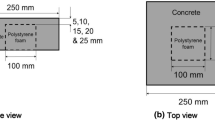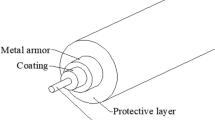Abstract
In the composite structure of a concrete-filled steel tube (CFST), because the concrete is concealed inside the steel tube, subsurface cavities can occur and are difficult to identify. In this study, a thermal-driven method based on Brillouin fiber-optic sensors (BFOSs) was proposed to quantitatively identify subsurface cavities in CFSTs. By performing a thermodynamic analysis of subsurface cavities in CFSTs, a thermal model related to the relationship between the subsurface cavity size and the temperature rise at the top surface of the CFST was established for the first time. Then, a sensing scheme based on the BFOS was proposed, and its feasibility was evaluated through an experimental program. The experimental program involved the use of an active heating layer for inputting heat flow into the CFST structure and BFOSs for the distributed measurement of temperature to identify subsurface cavities in CFSTs. The experimental results indicated that the BFOSs can achieve real-time distributed measurements of the surface temperature of the CFSTs. According to the temperature anomalies in the temperature rise curves of the CFSTs, the subsurface cavities can be accurately located in the longitudinal direction of the CFST, and its length can be quantified. There is an obvious linear relationship between the temperature rise and the square root of the heating time, from which the equivalent heat absorption coefficient (EHAC) can be determined. Furthermore, according to the relationship between the subsurface cavity height and the EHAC in the thermodynamic theoretical analysis, the subsurface cavity height can be obtained quantitatively.

















Similar content being viewed by others
References
Tokgoz S, Dundar C (2010) Experimental study on steel tubular columns in-filled with plain and steel fiber reinforced concrete. Thin Wall Struct 48(6):414–422
Li XQ, Luo MZ, Hei C et al (2019) Quantitative evaluation of debond in concrete-filled steel tubular member (CFSTM) using piezoceramic transducers and ultrasonic head wave amplitude. Smart Mater Struct 28(7):075033
Xu B, Zhang T, Song GB et al (2013) Active interface debonding detection of a concrete-filled steel tube with piezoelectric technologies using wavelet packet analysis. Mech Syst Signal Pr 36(1):7–17
Liu H, Xia HY, Zhuang MW et al (2019) Reverse time migration of acoustic waves for imaging based defects detection for concrete and CFST structures. Mech Syst Signal Pr 117:210–220
Xue JQ, Briseghella B, Chen BC (2012) Effects of debonding on circular CFST stub columns. J Constr Steel Res 69(1):64–76
Giri P, Kharkovsky S (2017) Detection of gap in concrete-metal structures using piezoelectric sensor technique. In: Proceedings of the 2017 IEEE international instrumentation measurement technology conference (I2MTC). Torino, Italy
Beena K, Shruti S, Sandeep S et al (2016) Monitoring degradation in concrete filled steel tubular sections using guided waves. Smart Struct Syst 19(4):371–382
Jiang TY, Luo ZT, Tian ZC, et al (2014) Investigation and application on monitoring the compactness of concrete-filled steel tube structures with ultrasonic wave. In: Earth and Space 2014—engineering for extreme environments. St. Louis, MO, USA
Dong W, Wu ZM, Zhou XM et al (2016) Experimental studies on void detection in concrete-filled steel tubes using ultrasound. Constr Build Mater 128:154–162
Pan WY, Zhao W, Li CY et al (2005) Ultrasonic testing of concrete filled steel tube compactness. China Railway Sci 26(3):64–67
Chen HB, Xu B, Mo YL et al (2018) Multi-scale stress wave simulation for aggregates segregation detection of concrete core in circular CFST coupled with PZT patches. Materials 11(7):1223
Nguyen KD, Ho DD, Kim JT (2013) Damage detection in beam-type structures via PZT’s dual piezoelectric responses. Smart Struct Syst 11(2):217–240
Giri P, Mishra S, Clark SM et al (2019) Detection of gaps in concrete-metal composite structures based on the feature extraction method using piezoelectric transducers. Sensors 19(8):1769
Zhang J, Xu JD, Guan WQ et al (2018) Damage detection of concrete-filled square steel tube (CFSST) column joints under cyclic loading using piezoceramic transducers. Sensors 18(10):3266
Yarnold MT, Moon FL (2015) Temperature-based structural health monitoring baseline for long-span bridges. Eng Struct 86:157–167
Reilly J, Glisic B (2018) Identifying time periods of minimal thermal gradient for temperature-driven structural health monitoring. Sensor 18(3):734
Freifeld BM, Finsterle S, Onstott TC et al (2008) Ground surface temperature reconstructions: using in situ estimates for thermal conductivity acquired with a fiber-optic distributed thermal perturbation sensor. Geophys Res Lett 35(14):L14309
Cheng CC, Cheng TM, Chiang CH (2008) Defect detection of concrete structures using both infrared thermography and elastic waves. Automat Constr 18(1):87–92
Pan SS, Zhu YX, Li DS et al (2018) Interface separation detection of concrete-filled steel tube using a distributed temperature measuring system. Appl Sci-Basel 8(9):1653
Ansari F (2015) Practical implementation of optical fiber sensors in civil structural health monitoring. J Intel Mat Syst Str 18(8):879–889
Feng X, Zhou J, Sun CS et al (2013) Theoretical and experimental investigations into crack detection with BOTDR-distributed fiber optic sensors. J Eng Mech 139(12):1797–1807
Bernini R, Fraldi M, Minardo A et al (2006) Identification of defects and strain error estimation for bending steel beams using time domain Brillouin distributed optical fiber sensors. Smart Mater Struct 15(2):612–622
Côté A, Carrier B, Leduc J et al (2007) Water leakage detection using optical fiber at the Peribonka dam. Geotech Spec Publ 175:1–12
Gong SL, Feng X (2020) Detection of grouting defects in prestressed tendon ducts using distributed fiber optic sensors. Struct Health Monit 9(4):1273–1286
Ouyang Y, Hird R, Bolton MD (2017) The use of fibre optic distributed sensing technology to detect changes in sediment overburden. Underw Technol 34(2):63–74
Feng X, Zhang XT, Sun CS et al (2014) Stationary wavelet transform method for distributed detection of damage by fiber-optic sensors. J Eng Mech-ASCE 140(4):04013004
Feng X, Han Y, Wang ZH et al (2018) Structural performance monitoring of buried pipelines using distributed fiber optic sensors. J Civ Struct Health Monit 8(3):509–516
Li GQ, Lou GB, Zhang C et al (2012) Assess the fire resistance of intumescent coatings by equivalent constant thermal resistance. Fire Technol 48(2):529–546
Acknowledgements
This article is based on a study supported by the Transportation Industry R&D Funding of Highway Bridge Diagnosis and Treatment Technique of China (No. 2018KFKT-08).
Author information
Authors and Affiliations
Corresponding author
Ethics declarations
Conflict of interest
The authors declare that they have no conflict of interest.
Additional information
Publisher's Note
Springer Nature remains neutral with regard to jurisdictional claims in published maps and institutional affiliations.
Rights and permissions
About this article
Cite this article
Gong, S., Feng, X. & Zhang, G. A thermal-driven method based on Brillouin fiber-optic sensors for the quantitative identification of subsurface cavities in concrete-filled steel tube structures. J Civil Struct Health Monit 11, 521–536 (2021). https://doi.org/10.1007/s13349-020-00464-7
Received:
Revised:
Accepted:
Published:
Issue Date:
DOI: https://doi.org/10.1007/s13349-020-00464-7




